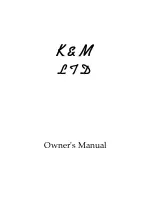
High Power Amp Teaching Resources
www.kitronik.co.uk/2143
LEDs & Current Limit Resistors
Before we look at LEDs, we first need to start with diodes. Diodes are used to control the direction of flow of
electricity. In one direction they allow the current to flow through the diode, in the other direction the current is
blocked.
An LED is a special diode. LED stands for Light Emitting Diode. LEDs are like normal diodes,
in that they only allow current to flow in one direction, however when the current is
flowing the LED lights.
The symbol for an LED is the same as the diode but with the addition of two arrows to
show that there is light coming from the diode. As the LED only allows current to flow in
one direction, it's important that we can work out which way the electricity will flow. This
is indicated by a flat edge on the LED.
For an LED to light properly, the amount of current that flows through it needs to be controlled. To do this we use a
current limit resistor. If we didn’t use a current limit resistor the LED would be very bright for a short amount of
time, before being permanently destroyed.
To work out the best resistor value we need to use Ohms Law. This connects the voltage across a device and the
current flowing through it to its resistance.
Ohms Law tells us that the flow of current (I) in a circuit is given by the voltage (V) across the circuit divided by the
resistance (R) of the circuit.
R
V
I
Like diodes, LEDs drop some voltage across them: typically 1.8 volts for a standard LED. However the high brightness
LED used in the ‘white light’ version of the lamp drops 3.5 volts.
The USB lamp runs off the 5V supply provided by the USB connection so there must be a
total of 5 volts dropped across the LED (V
LED
) and the resistor (V
R
). As the LED
manufacturer’s datasheet tells us that there is 3.5 volts dropped across the LED, there must
be 1.5 volts dropped across the resistor. (V
LED
+ V
R
= 3.5 + 1.5 = 5V).
LEDs normally need about 10mA to operate at a good brightness. Since we know that the
voltage across the current limit resistor is 1.5 volts and we know that the current flowing
through it is 0.01 Amps, the resistor can be calculated.
Using Ohms Law in a slightly rearranged format:
150
01
.
0
5
.
1
I
V
R
Hence we need a 150 current limit resistor.
















































